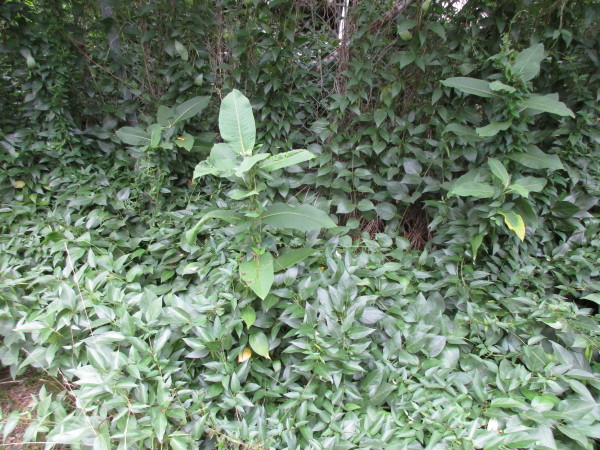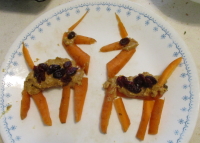craft adventures and self-care
Jul. 1st, 2022 09:26 amWe're coming up on the end of two weeks of travel, first to Florida to visit my family, and now in Virginia visiting my spouse's family. It has been really good, and I am sad that it is coming to an end.
Meanwhile, the world is threatening to tear itself apart and so many things are big and scary. The things that keep me grounded are being in nature, one-on-one connections, and doing things with my hands. That last one is particularly important, especially when it comes to crafts.
My parents' yard in Florida is overgrown with a bunch of plants that I don't know the names of, which is a bit disorienting when I'm used to living eating, weeding, and making things from familiar plants in Massachusetts. I still don't know most of them, but was able to successfully identify cat's claw vine (https://blogs.ifas.ufl.edu/pestalert/2021/01/22/cats-claw-vine-florida-invasive-plant-added-to-state-noxious-weed-list/), which is classified as "Category 1" invasive. There were actually only a few of the vines around in the yard, and---given that it is actually native to Central and South America and the West Indies---I get the sense that maybe its presence in Florida is part of a natural range expansion with climate change, and that perhaps the biggest concern about it is as an agricultural pest, but I decided that its invasive status was a good enough reason to pull the vines I was able to find and try making a basket out of them (see my previous post on crafts with invasive plants: https://alexandra-thorn.dreamwidth.org/55068.html).
The cat's claw vines are very slender but very nice to work with. As is my habit, I just pulled the vines and worked with them green. Here is the little basket I made:

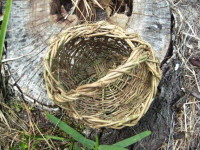
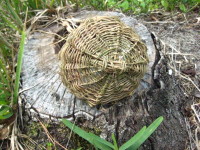
Here in Virginia, my mother-in-law, who is an avid potter, coached me through making a mug. I am very happy with the result:
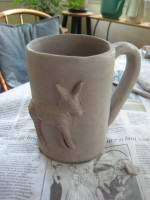
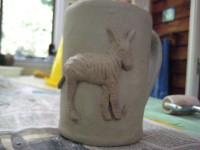
I've also been wanting for a while now to see what the notoriously invasive kudzu is like as a basket-weaving material. My spouse and I went on an expedition to the Rivanna River to find some, and located a large patch just as we were about to give up. The hike was pretty disheartening in a lot of ways. For a good quarter mile along the river we found no kudzu but lots and lots of oriental bittersweet and porcelain berries (not grapes, which we initially mistook them for), as well as catbriar and invasive yams. I think the only native vine we did see was poison ivy. There was also a lot of Japanese knotweed, ailanthus, and invasive roses. TimMc made a remark about coming through with an herbicide sprayer, and I said yes you could spray everything except the poison ivy, and then someone else will come by and spray the poison ivy and then this will look like a moonscape. The whole venture was a good case study in why it won't always work so well to just pull the invasives, that in this kind of space it really would be necessary to clear patches and work on getting native plants established there, and then work along the edges.
When we finally found the kudzu, it was growing on top of a patch of Japanese knotweed, because of course it was. It also turned out not to be what I was expecting (for some reason I thought it was woodier), but we gathered a few coils of the vines for me to play around with.
Back at the house, I spent some time in the woods pulling bittersweet vines. I gathered a bunch that had covered significant horizontal distance by coiling around a dead log. Interestingly, these horizonally-growing vines seemed much more flexible, more uniform in diameter, and generally easier to work with than the bittersweet vines I'd pulled off of trees previously. Perhaps something about growing in shade while the plant tries to cover distance.
In the end, I made a rather large basket mostly out of bittersweet, with the kudzu as just a single band of the weavers (shown between the two white bands of bittersweet with the bark removed). There are a number of clumsy aspects of the final basket, but it was fun to make something really big... facilitated by the rather long straight bittersweet vines I pulled:


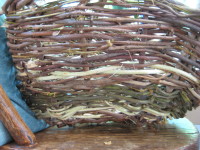
To round-out our travels, yesterday we went to an artificial beach on Chris Greene Lake. We spent a long time playing around in the water and seeing how close we could get to the fish that hung around the swim area. Toward the end, I had some fun arranging pebbles from the beach:
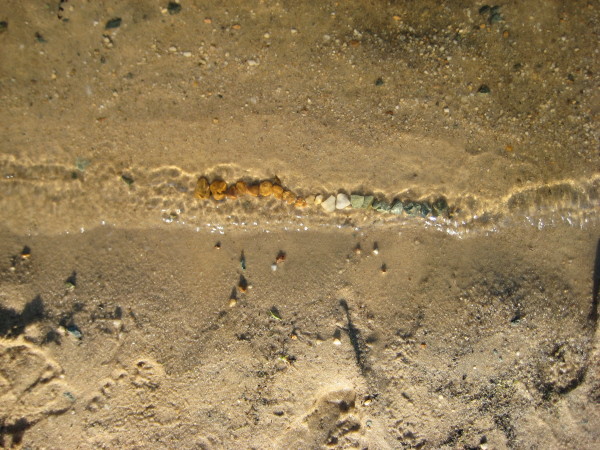
All of this has been good and much-needed grounding. Islands of sanity in a world of growing chaos.
Meanwhile, the world is threatening to tear itself apart and so many things are big and scary. The things that keep me grounded are being in nature, one-on-one connections, and doing things with my hands. That last one is particularly important, especially when it comes to crafts.
My parents' yard in Florida is overgrown with a bunch of plants that I don't know the names of, which is a bit disorienting when I'm used to living eating, weeding, and making things from familiar plants in Massachusetts. I still don't know most of them, but was able to successfully identify cat's claw vine (https://blogs.ifas.ufl.edu/pestalert/2021/01/22/cats-claw-vine-florida-invasive-plant-added-to-state-noxious-weed-list/), which is classified as "Category 1" invasive. There were actually only a few of the vines around in the yard, and---given that it is actually native to Central and South America and the West Indies---I get the sense that maybe its presence in Florida is part of a natural range expansion with climate change, and that perhaps the biggest concern about it is as an agricultural pest, but I decided that its invasive status was a good enough reason to pull the vines I was able to find and try making a basket out of them (see my previous post on crafts with invasive plants: https://alexandra-thorn.dreamwidth.org/55068.html).
The cat's claw vines are very slender but very nice to work with. As is my habit, I just pulled the vines and worked with them green. Here is the little basket I made:



Here in Virginia, my mother-in-law, who is an avid potter, coached me through making a mug. I am very happy with the result:


I've also been wanting for a while now to see what the notoriously invasive kudzu is like as a basket-weaving material. My spouse and I went on an expedition to the Rivanna River to find some, and located a large patch just as we were about to give up. The hike was pretty disheartening in a lot of ways. For a good quarter mile along the river we found no kudzu but lots and lots of oriental bittersweet and porcelain berries (not grapes, which we initially mistook them for), as well as catbriar and invasive yams. I think the only native vine we did see was poison ivy. There was also a lot of Japanese knotweed, ailanthus, and invasive roses. TimMc made a remark about coming through with an herbicide sprayer, and I said yes you could spray everything except the poison ivy, and then someone else will come by and spray the poison ivy and then this will look like a moonscape. The whole venture was a good case study in why it won't always work so well to just pull the invasives, that in this kind of space it really would be necessary to clear patches and work on getting native plants established there, and then work along the edges.
When we finally found the kudzu, it was growing on top of a patch of Japanese knotweed, because of course it was. It also turned out not to be what I was expecting (for some reason I thought it was woodier), but we gathered a few coils of the vines for me to play around with.
Back at the house, I spent some time in the woods pulling bittersweet vines. I gathered a bunch that had covered significant horizontal distance by coiling around a dead log. Interestingly, these horizonally-growing vines seemed much more flexible, more uniform in diameter, and generally easier to work with than the bittersweet vines I'd pulled off of trees previously. Perhaps something about growing in shade while the plant tries to cover distance.
In the end, I made a rather large basket mostly out of bittersweet, with the kudzu as just a single band of the weavers (shown between the two white bands of bittersweet with the bark removed). There are a number of clumsy aspects of the final basket, but it was fun to make something really big... facilitated by the rather long straight bittersweet vines I pulled:



To round-out our travels, yesterday we went to an artificial beach on Chris Greene Lake. We spent a long time playing around in the water and seeing how close we could get to the fish that hung around the swim area. Toward the end, I had some fun arranging pebbles from the beach:

All of this has been good and much-needed grounding. Islands of sanity in a world of growing chaos.


